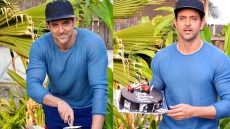TORONTO — In hindsight, the hellish shoot in the Canadian wilderness for "The Revenant" no longer seems so bad to the crew members who endured the brutal cold and whims of an incredibly meticulous director.
Picking up a slew of Oscar nominations will do that.
Academy members showed their appreciation for the work that went into "The Revenant," giving the film a leading 12 Oscar nominations including a nod for best picture and best actor for Leonardo DiCaprio, who plays real-life frontiersman Hugh Glass. Several Canadians who worked behind the scenes were also recognized for their work with an Oscar nomination.
"There were long hours, muddy feet, blood, sweat and tears," remembers set decorator Hamish Purdy, who was nominated in the production design category.
"It was a real journey, an adventure all the way."
Crew members in Alberta and British Columbia have described the challenges presented by director Alejandro Inarritu's ambitious 19th-century revenge thriller as something far beyond anything they'd ever faced before.
"I've been at this for 30 years and this is the most unique project I've worked on," says Edmonton-born Robert Pandini, nominated for makeup and hairstyling.
"(They) were less than ideal, but I loved working in the raw and rough conditions."
About a year ago, crew members were still toiling away on location as they turned Inarritu's vision into a reality.
"Everything we did in this movie is meant to be real and absolutely invisible," says Vancouver's Cameron Waldbauer, nominated in the best visual effects category for a second straight year.
"It's not about creating characters ... it's about seamlessly enhancing the story."
In the hair and makeup department, Pandini worked like a scientist to determine which adhesives would survive the deep-cold temperatures for the cast's hairpieces. On weekends, he stuffed his freezer with pieces of wigs to study how snow and ice would affect the hair.
"Some broke, some didn't do anything, some came out the wrong colour," Pandini recalls.

Artists were assigned by the director to craft a background for each character's follicles, with tales of lice infestation and hair loss caused by infection among the issues of the era.
Filming was almost entirely restricted to the "magic hour," a short window between sunrise and sunset when light levels are ideal for cinematography.
"Normally on a movie I would at least hire a wire man to help with all the practical lighting ... and there was none of that," Purdy says.
"There was candles, firelight and the sun."
Sound mixer Chris Duesterdiek, also nominated for an Oscar, says growing up an avid hiker in British Columbia didn't prepare him for the challenges of the film.
"We were definitely off-the-path on all of this," Duesterdiek says.
On the last day of filming, Duesterdiek learned exactly how extreme filming "The Revenant" could become, as he drove his truck five hours into the wilderness to capture sounds of a waterfall.
His truck wound up stuck in the mud. After a hearty struggle, he surrendered and called the production facility for help. Six hours would pass before help arrived.
"I thought, 'What would Hugh Glass do in this situation?'" Duesterdiek says.
So he pulled out a bag of beef jerky and a bottle of Chianti and awaited his rescue.
"That was a good way to end it — by myself in the woods."




